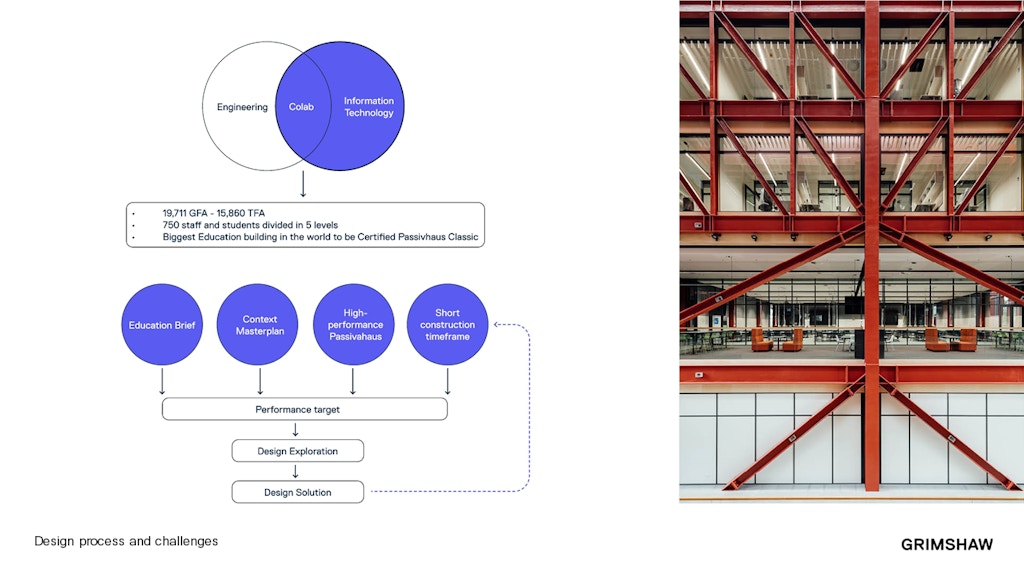The Monash Woodside Building
An Innovative-integrated design approach for Passive House in Australia
Presented on October 13, 2022 at Facade Tectonics 2022 World Congress
Sign in and Register
Create an Account
Overview
Abstract
Today’s environmental challenges highlight the necessity of a holistic approach to façade design and construction, key to achieve the ambitious 2030 and 2050 sustainability targets set for the construction sector. Passive House is recognised as a valuable approach to enable the shift towards a more sustainable way of design and construct buildings.
However, in Australia, this approach is still at its infancy, with less than 34 certified examples and only three not residential. In this context, the case study of The Woodside Building for Technology and Design, designed by Grimshaw Architects (Sydney practice) and Aurecon (Melbourne), in collaboration with Monash University (Melbourne, AU), provides a large-scale example of successful implementation of a novel approach to sustainability and Design for Manufacturing and Assembly. This educational building, the largest certified educational Passive House in the Southern Hemisphere, promotes new learning models, while setting a new standard for the Australian agenda on environmental innovation for the years to come.
This paper discusses the wholistic and integrated façade design process that allowed to achieve the highest standard in design excellence through the sophistication and diversity of the architectural response, while achieving the high energy performance targets set by Passive House, as well as allowing a short construction timeframe. It presents the environmental analysis undertaken during the design stage and the optimisation process required to adapt the Passive House paradigm to the Australian context. The paper benchmarks the final environmental performance against the 2019 Australian Building Code requirements to identify the performance gap generated by a design-for-compliancy approach, revealing that the design approach allowed to reduce the operational energy by approximately 60%. Investigating the resilience offered by high-performing envelopes to changing design assumptions, such as occupancy density, this analysis underlines the far-from-ambitious goals of current Australian policies, and it provides a snapshot of the Australian situation regarding energy efficiency, ultimately advocating for an important update of the construction policies.
Through a process of ‘Innovation by design’, the Woodside Building demonstrates that Passive House design framework can be used successfully to achieve world leading standards in energy efficiency for big scale education buildings and considerably improve the baseline provided by the local construction standards.
Authors

Alberto Sangiorgio
Principal Façade Engineer
Mott MacDonald
alberto.sangiorgio@mottmac.com

Andrew Cortese
Managing Partner and Design Director - Sydney Office
Grimshaw Architects
andrew.cortese@grimshaw.global

Walter van der Linde
Lead Engineer, Buildings Mechanical
Aurecon
Walter.vanderLinde@aurecongroup.com
Keywords
1. Introduction and Background
The Woodside Building for Technology and Design is a transformational learning and teaching facility for Monash University, built within the native landscapes of the Clayton Campus in Melbourne. A transdisciplinary facility for the Faculties of Engineering and Information Technology, it initiates new models of learning alongside academic research with industry-related enterprise, while simultaneously integrating precedent-establishing environmental innovation.
After completion in April 2020, the Building received the certification to Passive House (PH) classic, and today, with its 19’000m2 of GFA and 15’750m2 of TFA, is the biggest certified Passive House of the Southern hemisphere and arguably the biggest education building to reach this certification globally. The building, designed by Grimshaw Architects (Sydney) in collaboration with Aurecon and Monash University (Melbourne), embraces the best practices in integrated design, fundamental to face multidisciplinary challenges regarding the interface with the campus, the complexity of the program and brief in education, the tight timeframe (18months) and, of course, the high sustainability targets given by the Passive House certification.

The Passive House standard was created in Germany in the early ‘90s and it was quickly adopted in Europe, especially in Germany and Austria, as a best practice in the design and construction of ultra-low energy buildings.
Thanks to its performance-based nature, the PH approach does not drive the architectural design with prescriptive requirements but sets clear limitations on:
- Maximum values for energy peak or energy demand on heating and cooling + dehumidification,
- Minimum energy production from renewable energy,
- Minimum values of air tightness for the envelope.
In order to achieve these targets, architects, designers, and engineers can find the solutions that suit best the specific location, climate, and context.
Today Passive House counts more than 60,000 certified buildings and is a well-established energy performance certificate (EPC) especially in the northern part of Europe. Although Passive House has been internationally applied to different climates and contexts (Matsumoto et al., 2017; Schnieders et al, 2020; Schnieders et al, 2016) its use in Australia is still widely debated, whereby only 27 certified case studies are available (https://passivehouseaustralia.org). These cases are all residential and only one is not a single detached or terraced house (https://passivehouseaustralia.org). The reluctance of the market to use this certification scheme lies in the scepticism about the suitability of Passive House for the Australian climate, context, market and construction culture, besides the lack of examples beyond the residential typology.
In this context, the case study of the Woodside Building becomes relevant as it represents a unique adaptation of the Passive House principles to the Australian context and climate (Melbourne) of a big-scale education building. To deliver this outcome, the design team had to challenge the existing solutions typical of a PH and approach the design through a wholistic, integrated, data-based design process that encompassed all the building elements, including the façade (Figure 1).
The first section of this article describes this process, the definition of the main façade design features, and their relationship with the above-mentioned targets and with the other components of the building.
The second part of the article investigates the contribution of the envelope to the building energy demand, benchmarked against the Australia National Construction Code 2019 (NCC-2019) requirements to reveal the performance gap generated by a design-for-compliancy approach.
2. Façade Features and Design Process
The envelope design was embraced wholistically and not in isolation from the whole design process. The design process pushed towards innovative integrated design processes that enabled a wholistic and systemic
Access Restricted
3. Energy Benchmarking - Questions and Methods
This second part of the paper assesses the outcomes and environmental performance of different design approaches based on Passive House and the NCC-2019. The scenarios, defined based on the fundamental
Access Restricted
4. Results
The comparison between the different scenarios established according to Table 2, shows the following results, divided for cooling and heating demand:
Figure 13- Energy demand - Scenario comparisonThe Woodside
Access Restricted
5. Conclusions
This paper describes the main features and innovations related to the wholistic and integrated approach to the façade design of the Woodside Building, designed by Grimshaw Architects in collaboration with
Access Restricted
Acknowledgements
Acknowledgment and thanks are due to:
Michael Janeke – Partner and Project Director @ Grimshaw Architects (Sydney office)
Cristian Castillo – Project Architect @ Grimshaw Architects (Sydney office)
Bradford Gorman - Communications Advisor @ Grimshaw Architects (Sydney office)
Thanks also to Johanna Trickett, who assisted with the PHPP analysis.
Photo © Michael Kai
Rights and Permissions
Ambrose, M., James, M., Law, A., Osman, P. and S. White. 2013. The evaluation of the 5-star energy efficiency standard for residential buildings. Canberra AU. CSIRO https://publications.csiro.au/...
Australian Building Code Board. Australian Building Code 2019. BCA:2019, Canberra: AUSTRALIA
Hopfe, C., and R. McLeod. 2015. The The Passivhaus Designer’s Manual: A technical guide to low and zero energy buildings. 1st edition. London: Routledge.
Matsumoto, H., Tsuzuki, K., and L. Susanti, L. 2017. “Bioclimatic Analysis in Pre‐Design Stage of Passive House in Indonesia.” Buildings 7, no. 1(March): 24.
Passive House Association – Australia. 2019. Passive House Database. https://passivehouseaustralia....
Sangiorgio, A. (2022). Façade innovation: an industry perspective. In Rethinking Building Skins (pp. 15-58). Woodhead Publishing.
Schnieders, J., Eian, T.D., Filippi, M. et al. 2020. “Design and realisation of the Passive House concept in different climate zones.” Energy Efficiency 13 (September):1561–1604.
Schnieders, J., Feist, W., and L. Rongen. 2015. “Passive Houses for different climate zones.” Energy and Buildings 105 (Octboer): 71-87.